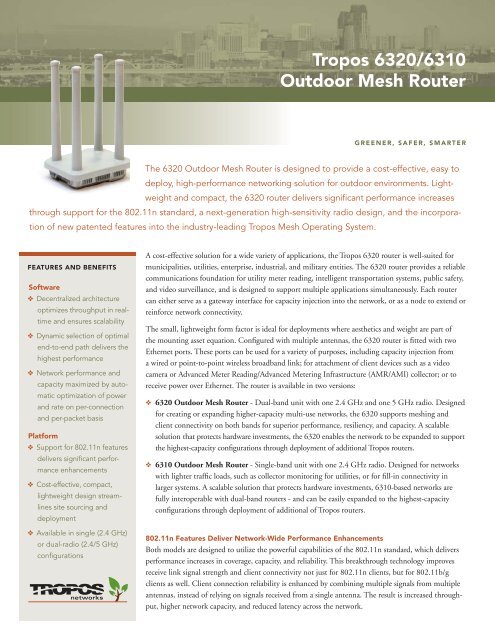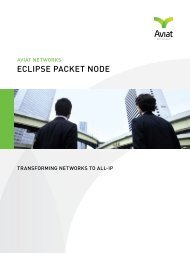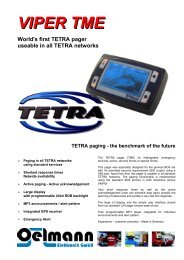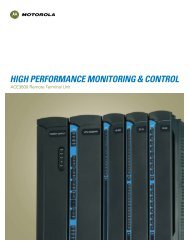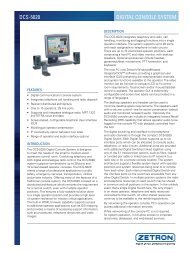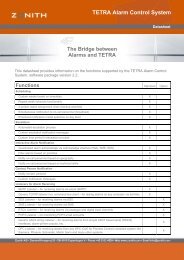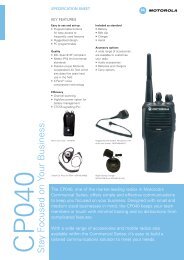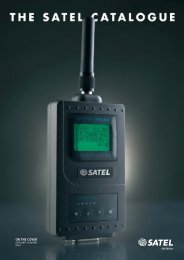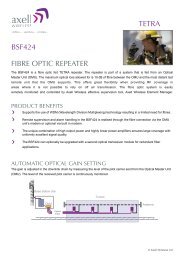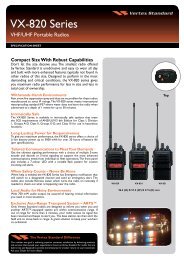Tropos 6320 Datasheet - Sigma Wireless
Tropos 6320 Datasheet - Sigma Wireless
Tropos 6320 Datasheet - Sigma Wireless
You also want an ePaper? Increase the reach of your titles
YUMPU automatically turns print PDFs into web optimized ePapers that Google loves.
<strong>Tropos</strong> <strong>6320</strong>/6310<br />
Outdoor Mesh Router<br />
GREENER, SAFER, SMARTER<br />
The <strong>6320</strong> Outdoor Mesh Router is designed to provide a cost-effective, easy to<br />
deploy, high-performance networking solution for outdoor environments. Lightweight<br />
and compact, the <strong>6320</strong> router delivers significant performance increases<br />
through support for the 802.11n standard, a next-generation high-sensitivity radio design, and the incorporation<br />
of new patented features into the industry-leading <strong>Tropos</strong> Mesh Operating System.<br />
FEATURES AND BENEFITS<br />
Software<br />
❖ Decentralized architecture<br />
optimizes throughput in realtime<br />
and ensures scalability<br />
❖ Dynamic selection of optimal<br />
end-to-end path delivers the<br />
highest performance<br />
❖ Network performance and<br />
capacity maximized by automatic<br />
optimization of power<br />
and rate on per-connection<br />
and per-packet basis<br />
Platform<br />
❖ Support for 802.11n features<br />
delivers significant performance<br />
enhancements<br />
❖ Cost-effective, compact,<br />
lightweight design streamlines<br />
site sourcing and<br />
deployment<br />
❖ Available in single (2.4 GHz)<br />
or dual-radio (2.4/5 GHz)<br />
configurations<br />
A cost-effective solution for a wide variety of applications, the <strong>Tropos</strong> <strong>6320</strong> router is well-suited for<br />
municipalities, utilities, enterprise, industrial, and military entities. The <strong>6320</strong> router provides a reliable<br />
communications foundation for utility meter reading, intelligent transportation systems, public safety,<br />
and video surveillance, and is designed to support multiple applications simultaneously. Each router<br />
can either serve as a gateway interface for capacity injection into the network, or as a node to extend or<br />
reinforce network connectivity.<br />
The small, lightweight form factor is ideal for deployments where aesthetics and weight are part of<br />
the mounting asset equation. Configured with multiple antennas, the <strong>6320</strong> router is fitted with two<br />
Ethernet ports. These ports can be used for a variety of purposes, including capacity injection from<br />
a wired or point-to-point wireless broadband link; for attachment of client devices such as a video<br />
camera or Advanced Meter Reading/Advanced Metering Infrastructure (AMR/AMI) collector; or to<br />
receive power over Ethernet. The router is available in two versions:<br />
❖ <strong>6320</strong> Outdoor Mesh Router - Dual-band unit with one 2.4 GHz and one 5 GHz radio. Designed<br />
for creating or expanding higher-capacity multi-use networks, the <strong>6320</strong> supports meshing and<br />
client connectivity on both bands for superior performance, resiliency, and capacity. A scalable<br />
solution that protects hardware investments, the <strong>6320</strong> enables the network to be expanded to support<br />
the highest-capacity configurations through deployment of additional <strong>Tropos</strong> routers.<br />
❖ 6310 Outdoor Mesh Router - Single-band unit with one 2.4 GHz radio. Designed for networks<br />
with lighter traffic loads, such as collector monitoring for utilities, or for fill-in connectivity in<br />
larger systems. A scalable solution that protects hardware investments, 6310-based networks are<br />
fully interoperable with dual-band routers - and can be easily expanded to the highest-capacity<br />
configurations through deployment of additional of <strong>Tropos</strong> routers.<br />
802.11n Features Deliver Network-Wide Performance Enhancements<br />
Both models are designed to utilize the powerful capabilities of the 802.11n standard, which delivers<br />
performance increases in coverage, capacity, and reliability. This breakthrough technology improves<br />
receive link signal strength and client connectivity not just for 802.11n clients, but for 802.11b/g<br />
clients as well. Client connection reliability is enhanced by combining multiple signals from multiple<br />
antennas, instead of relying on signals received from a single antenna. The result is increased throughput,<br />
higher network capacity, and reduced latency across the network.
<strong>Tropos</strong> Mesh OS<br />
The <strong>Tropos</strong> Mesh OS is the cornerstone of the decentralized <strong>Tropos</strong><br />
System Architecture. A common software platform that runs on each<br />
router across the network, the <strong>Tropos</strong> Mesh OS leverages the router’s<br />
on-board intelligence to monitor and maximize performance. Unlike<br />
controller-based architectures that suffer bandwidth losses as control<br />
traffic is passed back and forth between network nodes and the<br />
central site, the distributed <strong>Tropos</strong> System Architecture uses efficient<br />
on-board processing at the device level to minimize network congestion<br />
and adapt on a real-time, packet-by-packet scale. This distributed<br />
approach optimizes performance and throughput by minimizing<br />
control traffic, delivers a highly scalable solution, and helps provide a<br />
quality user experience for network clients.<br />
PWRP<br />
The cornerstone of the <strong>Tropos</strong> Mesh OS is the patented Predictive<br />
<strong>Wireless</strong> Routing Protocol (PWRP), which continually analyzes<br />
the quality of active and inactive mesh links to dynamically configure<br />
the ideal combination of paths to optimize network performance.<br />
Upon deployment, the routers automatically discover one<br />
another, and quickly determine the optimal route to the gateways<br />
that inject capacity into the network. Optimal links are chosen on<br />
the basis of throughput, packet success, signal-to-noise ratios, and<br />
other key criteria.<br />
PWRP performs a range of key tasks across the wireless network:<br />
❖ Streamlines deployments and preserves performance by dynamically<br />
configuring and optimizing mesh connections<br />
❖ Improves overall throughput by selecting optimal routing paths<br />
❖ Enhances network resiliency by providing graceful rerouting of<br />
traffic in the event of RF interference, backhaul failures, or other<br />
disruptions in the wireless mesh<br />
❖ Supports client mobility without the need for special client hardware,<br />
software, or network reconfigurations<br />
❖ Enables the network to be scaled to thousands of nodes covering<br />
the largest geographical areas in the industry<br />
PowerCurve<br />
A distributed algorithm that leverages the <strong>Tropos</strong> PWRP communication<br />
protocol, PowerCurve maximizes network performance and<br />
capacity by automatically optimizing power and rate parameters<br />
on a per-connection and per-packet basis. This advanced, distributed<br />
algorithm continually adjusts transmit power to maximize<br />
the number of wireless links that can operate concurrently. Unlike<br />
alternative approaches where transmit power is configured as<br />
a static setting, PowerCurve tightly couples power and bit rate<br />
control. This enables the router to make continuous and dynamic<br />
adjustments that can enhance throughput and provide a better user<br />
experience.<br />
PowerCurve delivers the following key benefits:<br />
❖ Dynamically monitors and adjusts power and rate per-packet,<br />
per-link, to deliver maximum capacity<br />
❖ Enhances network reliability, capacity, and scalability beyond the<br />
capabilities of controller-based architectures<br />
❖ Streamlines network planning, deployment, and optimization<br />
Airtime Congestion Control<br />
Airtime Congestion Control (ACC) technology enables networks to be<br />
operated closer to their capacity limits by detecting signs of congestion<br />
and dynamically adjusting airtime resource allocation to clients. ACC<br />
is unlike traditional rate limiting in two important ways. First, instead<br />
of limiting traffic during congestion-free periods, ACC activates only<br />
when performance-impacting congestion is detected and returns to<br />
a monitoring state afterward. Second, it is mesh- and wireless-aware,<br />
distributing airtime resources equally among clients during a congestion<br />
event rather than applying fixed throughput caps. By allowing networks<br />
to carry heavy traffic loads without crossing over into a saturated<br />
state, ACC actually increases usable capacity.<br />
❖ Deterministic allocation of airtime resources enables networks to<br />
run at higher capacity without congestion<br />
❖ Monitors airtime availability to deliver more efficient network<br />
utilization than systems relying on limiting traffic levels<br />
❖ Provides fair network access to all users, enabling <strong>Tropos</strong> to<br />
surpass traditional broadband wireless network capacity<br />
GREENER, SAFER, SMARTER
Smart Channel<br />
Designed to optimize performance in both single- and dual-radio<br />
networks, this distributed algorithm continually samples all available<br />
channels to analyze link performance and interference trends.<br />
The channel decision logic is integrated into the PWRP routing<br />
algorithms so that end-to-end path qualities are assessed on alternate<br />
channels. In dual-radio systems, fine-grained channel plans are<br />
implemented within individual clusters to optimize each cell for client<br />
coverage and spectral reuse.<br />
❖ Provides continuous monitoring of all channels to detect intermittent<br />
noise sources<br />
❖ Non-disruptive to user traffic and sessions<br />
❖ Avoids interference and enhances network capacity and reliability<br />
Advanced Network Management Platform Delivers<br />
Optimized Edge-to-Edge Visibility<br />
<strong>Tropos</strong> Control is a standards-based network management system<br />
designed to achieve peak performance and reliability. Designed<br />
around an intuitive Web-based interface, the software facilitates the<br />
remote management of <strong>Tropos</strong> Mesh networks, and is ideal for<br />
dynamically deploying and configuring networks ranging in size<br />
from tens to thousands of <strong>Tropos</strong> routers. <strong>Tropos</strong> Control minimizes<br />
planning, deployment, and operating costs, and increases the<br />
efficiency of management personnel by performing complex tasks<br />
such as global provisioning and software updates across the network<br />
in a single session.<br />
❖ Streamlines tasks such as monitoring<br />
network health, statistical network<br />
performance analysis, and performance<br />
optimization<br />
❖ Network Health dashboard provides at-a-glance views of network<br />
traffic, performance, and alarms with links to instantly drill<br />
down to relevant statistical information<br />
❖ <strong>Wireless</strong>-aware provisioning for guaranteed configuration<br />
changes and software updates over dynamically changing links<br />
❖ Detailed historical database of RF environmental data, network<br />
performance, and client connectivity enables fast root-cause<br />
diagnosis<br />
❖ Assists network managers to plan future expansions and optimization<br />
strategies based on analysis of network trends and detailed<br />
historical information<br />
Resilient, High-Performance Networks From <strong>Tropos</strong> – the<br />
<strong>Wireless</strong> IP Broadband Market Leader<br />
As the leader in wireless IP broadband mesh networking solutions,<br />
<strong>Tropos</strong> is the right choice for organizations interested in deploying<br />
a robust infrastructure capable of withstanding the harshest outdoor<br />
environments. Designed to contain costs and enhance productivity,<br />
<strong>Tropos</strong> technology provides the backbone for top-performing<br />
outdoor wireless IP networks across the globe. As the industry<br />
continues to evolve, <strong>Tropos</strong> is poised to extend its market leadership<br />
through the introduction of innovative products and functionality.<br />
For further information visit us on the web at www.tropos.com.<br />
<strong>Tropos</strong> fixed and mobile routers can be used for securely<br />
operating a wide range of services<br />
❖ Provides macro-level visibility as well as<br />
granular real-time and historical detail<br />
on usage, link quality, capacity, and<br />
network reliability<br />
<strong>Tropos</strong> <strong>6320</strong><br />
Mobile Worker<br />
802.11 a/b/g/n<br />
Alternative wired/wireless<br />
Wired Collector<br />
GREENER, SAFER, SMARTER
<strong>Wireless</strong><br />
• IEEE 802.11b/g/n radio<br />
– Frequency band: 2.4-2.483 GHz<br />
– Modulation: 802.11g/n - OFDM (64-QAM,<br />
16-QAM, QPSK, BPSK); 802.11b - DSSS<br />
(DBPSK, DQPSK, CCK)<br />
– Media Access Protocol: CSMA/CA with ACK<br />
– X Power: ETSI/EU 5-20 dBm (EIRP) set in 1 dB<br />
units; FCC/IC 20-35 dBm (EIRP) set in 1 dB units<br />
– Multi-Antenna System: 1-TX x 3-RX<br />
– Support for 802.11n MRC<br />
– 6 dBi Integrated omnidirectional antennas<br />
– RX Sensitivity:<br />
-97 dBm @ 1 Mbps -95 dBm @ 18 Mbps<br />
-94 dBm @ 5.5 Mbps -92 dBm @ 24 Mbps<br />
-92 dBm @ 11 Mbps -89 dBm @ 36 Mbps<br />
-96 dBm @ 6 Mbps -85 dBm @ 48 Mbps<br />
-96 dBm @ 12 Mbps -84 dBm @ 54 Mbps<br />
• IEEE 802.11a radio<br />
– Frequency band: 5.725 - 5.850 GHz (FCC/IC)<br />
5.470 - 5.725 GHz with DFS (ETSI/EU)<br />
– Modulation: 802.11a/n - OFDM (64-QAM,<br />
16-QAM, QPSK, BPSK)<br />
– Media Access Protocol: CSMA/CA with ACK<br />
– TX Power: ETSI/EU 15-30 dBm (EIRP) set in 1<br />
dB units; FCC/IC 19-34 dBm (EIRP) set in 1<br />
dB units<br />
– 8 dBi Omnidirectional antenna<br />
– RX Sensitivity:<br />
-94 dBm @ 6 Mbps -86 dBm @ 24 Mbps<br />
-93 dBm @ 9 Mbps -83 dBm @ 36 Mbps<br />
-92 dBm @ 12 Mbps -78 dBm @ 48 Mbps<br />
-89 dBm @ 18 Mbps -76 dBm @ 54 Mbps<br />
Networking<br />
• Full 802.11b/g, 802.11a, 802.11n Client<br />
Compatibility<br />
• IEEE 802.3u 10/100BaseT Ethernet Ports<br />
• BGP<br />
• 802.1q VLAN Support (ESSID and IP based<br />
tagging)<br />
• Support for static and dynamic addressing for<br />
wireless and wired clients<br />
• Onboard DHCP Server and Relay<br />
• Plug and Play Wired Client Interface<br />
• Session-Persistent Mobility across Subnets<br />
• Location Based Services<br />
• Layer 2 Emulation (L2E)<br />
• NAT<br />
Quality of Service<br />
• 802.11e WMM<br />
• 802.1p/q with 4 queues per VLAN and ESSID<br />
• 802.1p and DSCP<br />
• VoIP and VoWiFi Support<br />
– Heuristics-based Voice Classification<br />
– Call Admission Control<br />
– TSpec Classification<br />
– Seamless Mobility<br />
– Call Reporting<br />
• Rate Limiting (Airtime and Throughput Based)<br />
Management<br />
• RADIUS Accounting<br />
• Local and Remote Management Tools via<br />
HTTPS<br />
• Router Access Control<br />
• Identity-Based Authentication (4 levels)<br />
• Configuration Save and Restore<br />
• Software Upgrades with Rollback<br />
• Command Line Interface (CLI) via SSH<br />
• SNMP (standard MIBs and <strong>Tropos</strong> MIB)<br />
• <strong>Wireless</strong>, Network and Client Monitoring and<br />
Statistics<br />
Security<br />
• Authentication: WPA, WPA2, 802.11i,<br />
RADIUS, 802.1x (includes EAP-TLS, EAP-<br />
TTLS, EAP-SIM, PEAP)<br />
• Encryption: Open, WEP, AES-CCM, TKIP<br />
• Hardware assisted encryption<br />
• AES encryption of mesh and control traffic<br />
• Multiple BSSIDs & ESSIDs (ESSID suppression)<br />
• Full VPN compatibility (VPN filtering)<br />
• Password and Certificate-based HTTPS and SSH<br />
Remote Access<br />
• Packet Filtering & Forwarding<br />
• Peer-to-Peer Blocking<br />
• Client Access Control Lists<br />
• Router Access Control<br />
• Evil Twin Detection and Reporting<br />
• Denial of Service Attack Detection<br />
• Tamper-Evident Seal<br />
• FIPS 140-2 Level 2 certified<br />
Environmental Specifications<br />
• Operating temperature range: -40°C to 55°C<br />
• Storage temperature range: -40°C to 85°C<br />
• Weather rating: IP67<br />
• Wind survivability: >165 mph<br />
• Wind loading (165 mph):


